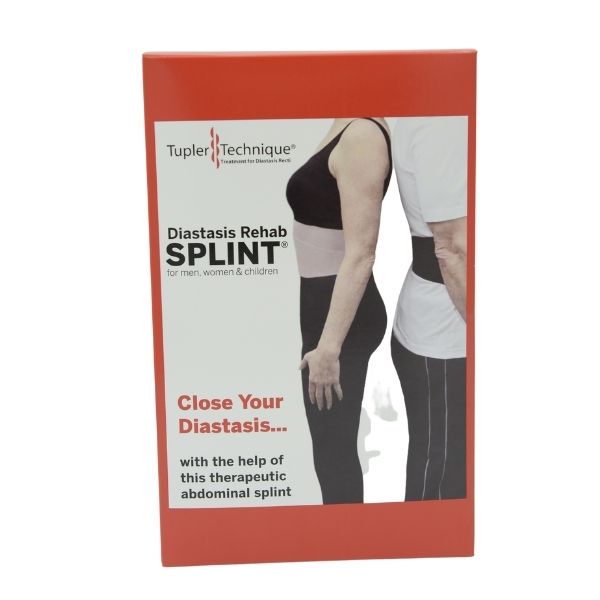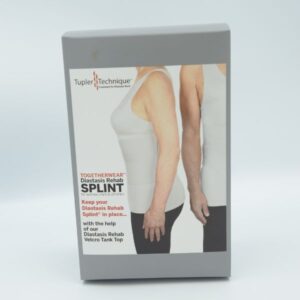Description
Putting on a Diastasis Rehab Splint® correctly is important to make sure it will be both comfortable and effective in closing your diastasis. CLICK HERE to learn how to put on your splint correctly whether you are wearing one regular or short torso splint or whether you are wearing two splints. If you are putting your splint on correctly and your belly bulges out the bottom, it means you need more coverage and you should wear two splints. To purchase a second splint either for more coverage, to keep it in place better or so you can wash the splint you are wearing.
Splint Content Description
Outer Pad – 80% Nylon, 20% Spandex
Inner
Pad – 50% Polyurethane, 50% Nylon
Elastic Arms – 60% Dacron 40% Rubber Thread
Velcro Hook – 100% Nylon
Splint Care: Hand Wash & Air Dry Only
The purpose of the splint is to “re-position” both the connective tissue and the separated muscles in a better position to make your diastasis recti smaller. The connective tissue needs to be in a narrow position to heal and the muscles need to be close together so they move in the right direction. Front to back instead of sideways. Our splint will not weaken your abdominal muscles. The purpose of other abdominal binders is “compression” or bringing your abdominals back towards your spine. That is the job of your innermost transverse abdominal muscle. Once you strengthen your transverse muscle with the Tupler Technique® exercises your transverse muscle can be your compression binder!
Wearing a Diastasis Rehab Splint® is just ONE of the 4 steps of the Tupler Technique® Program. You must do the other 3 steps taught in the Diastasis Rehab video to close your diastasis. If you are just wearing the splint and not doing the exercises you will not close your diastasis. You need to wear the splint until the connective tissue is strong enough to hold the muscles together.
Please wear the splint ALL the time. Even when you sleep. Take it off to bathe for 15 minutes. Make sure you clean and dry your belly button before putting your splint back on. If you broke your leg you would have to wear the cast all the time to continuously keep the two separated ends of the bone together so they heal. It is the same with connective tissue. You must continuously keep it in the same narrow position so it heals. You will know it has healed when it is shallow and you can’t feel the muscles grabbing your fingers when you check it.
Your splint will stay in place better if you wear it over a fitted undergarment and keep your back flat when getting up and down from a seated to standing position or when bending over. Arching or rounding your back will make it move out of place.
Please stand in front of a mirror when putting on your splint so you put it on correctly. Attaching and detaching the splint too many times can decrease the effectiveness of the splint.The hook part of the velcro takes away the filaments on the loop part of the velcro. So adjust it instead of pulling the hook off the loop. Turn to the side when you are attaching the arms of your splint so you can see where you are attaching them. They need to be attached to the pad. If it is not on the pad it will scratch your skin. If you attach the arms too low it will affect the arm underneath it. The arms need to attach on the side of your splint. If they are attaching in the back, they are too long and you need to shorten them. You can do this by taking off the hook velcro at the end of the elastic arm, cutting the elastic and then sewing the hook velcro back on.
CONTRAINDICATIONS FOR WEARING A SPLINT
After a C-section birth, it is important for you to wait until your scar has healed before you start wearing the splint. If you have a medical condition and are under doctor’s care please speak to your doctor about wearing a splint and doing our program. Many physicians do not know about our research and evidence based program. So if you email us, Julie is glad to speak with your doctor about our program to see if it is appropriate for you. There are many ways to “modify” our program for many medical conditions. This splint can be worn during pregnancy. We recommend starting to wear it in your second trimester when you are feeling better. Wearing a splint can cause nausea which is also a common symptom in your first trimester. The exercises, however, can be started in the first trimester while holding a splint (scarf).
Holding a splint may also be necessary with other medical conditions instead of wearing our Diastasis Rehab Splint®. When you bring the two separated muscles together you will be putting the displaced abdominal organs back to their original position. This may cause pressure on the organs above (heart) and below (pelvic floor) them. So if you have any heart conditions it is best to not wear a splint. Also, wearing a splint with a hiatal hernia may create problems.
If you have any type of pelvic floor prolapses you can wear a splint as long as you do not feel any pressure on your pelvic floor. If you do feel pressure, then just “hold” the splint when doing the seated or back lying exercises. If you are wearing the splint, make sure to engage both your transverse and pelvic floor muscles when you are putting it on. Also, when doing the exercises:
- Count out loud. Holding your breath puts pressure on both the pelvic floor and weak connective tissue joining the abdominal muscles.
- Engage both the abdominal and the pelvic floor muscles at the same time when doing the seated and back lying exercises
- Decrease the repetitions of the seated contracting exercise repetitions when doing the contracting exercises from 100 to 25 or less.





Reviews
There are no reviews yet.